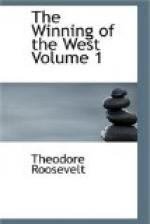Backwoods society was simple, and the duties and rights of each member of the family were plain and clear. The man was the armed protector and provider, the bread-winner; the woman was the housewife and child-bearer. They married young and their families were large, for they were strong and healthy, and their success in life depended on their own stout arms and willing hearts. There was everywhere great equality of conditions. Land was plenty and all else scarce; so courage, thrift, and industry were sure of their reward. All had small farms, with the few stock necessary to cultivate them; the farms being generally placed in the hollows, the division lines between them, if they were close together, being the tops of the ridges and the watercourses, especially the former. The buildings of each farm were usually at its lowest point, as if in the centre of an amphitheatre.[23] Each was on an average of about 400 acres,[24] but sometimes more.[25] Tracts of low, swampy grounds, possibly some miles from the cabin, were cleared for meadows, the fodder being stacked, and hauled home in winter.
Each backwoodsman was not only a small farmer but also a hunter; for his wife and children depended for their meat upon the venison and bear’s flesh procured by his rifle. The people were restless and always on the move. After being a little while in a place, some of the men would settle down permanently, while others would again drift off, farming and hunting alternately to support their families.[26] The backwoodsman’s dress was in great part borrowed from his Indian foes. He wore a fur cap or felt hat, moccasins, and either loose, thin trousers, or else simply leggings of buckskin or elk-hide, and the Indian breech-clout. He was always clad in the fringed hunting-shirt, of homespun or buckskin, the most picturesque and distinctively national dress ever worn in America. It was a loose smock or tunic, reaching nearly to the knees, and held in at the waist by a broad belt, from which hung the tomahawk and scalping-knife.[27] His weapon was the long, small-bore, flint-lock rifle, clumsy, and ill-balanced, but exceedingly accurate. It was very heavy, and when upright, reached to the chin of a tall man; for the barrel of thick, soft iron, was four feet in length, while the stock was short, and the butt scooped out. Sometimes it was plain, sometimes ornamented. It was generally bored out—or, as the expression then was, “sawed out”—to carry a ball of seventy, more rarely of thirty or forty, to the pound; and was usually of backwoods manufacture.[28] The marksman almost always fired from a rest, and rarely at a very long range; and the shooting was marvellously accurate.[29]




